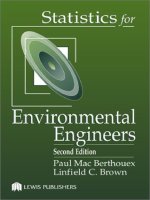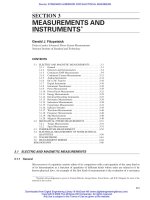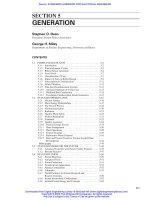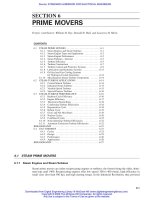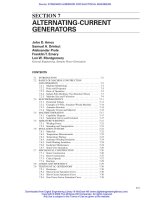C gribble geology for civil engineers
Bạn đang xem bản rút gọn của tài liệu. Xem và tải ngay bản đầy đủ của tài liệu tại đây (9.49 MB, 348 trang )
GEOLOGY FOR CIVIL ENGINEERS
TITLES OF RELATED INTEREST
Construction Methods and Planning
J.R.Illingworth
Contaminated Land—Problems and Solutions
Edited by T.Cairney
Engineering the Channel Tunnel
Edited by C.Kirkland
Engineering Treatment of Soils
F.G.Bell
Foundations of Engineering Geology
A.C.Waltham
Geology of Construction Materials
J.F.Prentice
Pile Design and Construction Practice
M.J.Tomlinson
Piling Engineering
W.G.K.Fleming, A.J.Weltman, M.F.Randolph and W.K.Elson
Rock Mechanics for Underground Mining
B.H.G.Brady and E.T.Brown
Rock Slope Engineering
E.Hoek and J.W.Bray
Rutley’s Elements of Mineralogy
C.D.Gribble
The Stability of Slopes
E.N.Bromhead
Soil Mechanics
R.F.Craig
Underground Excavations in Rock
E.Hoek and E.T.Brown
For details of these and other titles, contact the Marketing Department
E & FN Spon, 11 New Fetter Lane, London EC4P 4EE, UK.
Tel: +44(0) 171 842 2180
GEOLOGY FOR CIVIL
ENGINEERS
Second Edition
A.C.McLean C.D.Gribble
University of Glasgow
First published 1979 by E & FN Spon, an imprint of Chapman & Hall
Second edition 1985
This edition published in the Taylor & Francis e-Library, 2005.
“To purchase your own copy of this or any of Taylor & Francis or
Routledge's collection of thousands of eBooks please go to
www.eBookstore.tandf.co.uk.”
© 1979 A.C.McLean; 1979, 1985 C.D.Gribble
All rights reserved. No part of this book may be reprinted or reproduced or
utilized in any form or by any electronic, mechanical, or other means, now
known or hereafter invented, including photocopying and recording, or in
any information storage or retrieval system, without permission in writing
from the publishers.
British Library Cataloguing in Publication Data
A catalogue record for this book is available from the British Library
ISBN 0-203-36215-2 Master e-book ISBN
ISBN 0-203-37473-8 (Adobe e-Reader Format)
ISBN 0-419-16000-0 (pbk)
zvvii
This book is
dedicated to the memory of
Dr Adam McLean
zvviii
Preface to the second edition
Adam McLean and I were asked by Roger Jones of Allen & Unwin to consider producing
a second edition of our book after the first edition had been published for a few years.
Critical appraisals of the first edition were sought, and I am most grateful to Professor
Van Dine and Dr Drummond for their many detailed and helpful comments. I should also
particularly like to thank Dr Bill French, who pointed out where corrections were
required and also where additions (and subtractions) to the text could gainfully be made
without changing the original flavour of our book. I have incorporated most of these
helpful suggestions and hope that the text has been improved, but any mistakes and
inaccuracies are mine.
At the beginning of the revision Adam McLean became ill, and the illness got
progressively worse until, in March 1983, he died. In memory of all the enjoyment we
had with the first edition, I should like to dedicate the second edition to Adam with my
respect.
Colin Gribble
Glasgow, September 1983
zvix
Preface to the first edition
The impulse to write this book stemmed from a course of geology given by us to
engineering undergraduates at the University of Glasgow. The course has changed, and
we hope improved, during the twenty years since one of us was first involved with it. It
was essentially a scaled-down version of an introductory course to science
undergraduates; it is now radically different both in content and in the mode of teaching
it. Our main thought, as we gradually reshaped it, was to meet the special interests and
professional needs of budding civil engineers. It is a matter for serious debate as to
whether time should be found within an engineering course for classes of a broad cultural
nature. Our experience in teaching indicates that the relevance of subject matter to the
vocation of those taught usually increases their interest and enthusiasm. Furthermore, in
engineering curricula which are being crowded by new and professionally useful topics,
we doubt whether a place would have been found for a general course on geology which
discussed, for example, the evolution of the vertebrates or the genetic relationship of the
various basic plutonic rocks. On the other side of the scale, we have firm beliefs that
educated men and women should be aware of the Theory of Natural Selection and its
support from the fossil record, and should be aware of other major scientific concepts
such as plate tectonics. We have found some space for both of these in our book. Other
apparent digressions from what is obviously relevant may serve a professional purpose.
For example, civil engineers must have an insight into how geologists reach conclusions
in making a geological map, in order to evaluate the finished map. Similarly, they should
appreciate how and why geologists differentiate between (say) gabbro and diorite, not
because these differences are important for most engineering purposes but so that they
can read a geological report sensibly and with the ability to sift the relevant from the
irrelevant information.
Our course and this book are essentially an introduction to geology for civil engineers,
which is adequate for the needs of their later careers, and on which further courses of
engineering geology, soil mechanics or rock mechanics can be based. They are not
conceived as a course and text on engineering geology. We have, however, extended the
scope of the book beyond what is geology in the strict sense to include engineering
applications of geology. This is partly to demonstrate the relevance of geology to
engineering, and partly in the expectation that the book, with its appendices, will also
serve as a useful handbook of facts and methods for qualified engineers and other
professionals who use geology. The reactions of the majority of those who reviewed our
first draft reassured us that our ideas were not peculiar to ourselves, and that we were not
the only teachers of geology who felt the need for a textbook tailored to them. Other
views ranged from a preference for altering the book to make it a comprehensive account
of the whole of geology largely devoid of material on engineering, to a preference for a
zvx
more radical change along the lines we were following, which would have produced an
introductory text in engineering geology rather than geology. The balance of opinion
seemed reasonably close to our own prescription, though we are grateful for the many
constructive suggestions that have led to major changes of content and arrangement as
well as minor amendments. If we have not ended at the centre of the many opinions that
colleagues and friends have kindly given us, it is because at the end of the day we have
special interests and views ourselves, and it is our book. We hope that you will find it
useful and readable.
ADAM McLEAN
COLIN GRIBBLE
Glasgow, August 1978
zvxi
Acknowledgements
We wish to thank the friends and colleagues who assisted us generously and patiently by
their advice, by their critical reading of our text and by their encouragement. We
considered carefully all the points that they made, and many significant improvements
from our original draft are witness to this, just as any persistent failings, and any errors,
are our own responsibility. A special thank you is due to Professor W.Dearman of the
University of Newcastle, Professor P.McL.Duff of the University of Strathclyde, Dr
I.Hamilton of Paisley College of Technology, Dr D. Wilson of the University of
Liverpool, and Professor Boyd of the University of Adelaide, for reading critically the
entire text and making a host of useful comments. We were fortunate in being able to
discuss particular sections of the book with friends, whose specialised knowledge was a
source of expert opinion and information, and we thank all of them sincerely. They
include Mr R.Eden, Assistant Director BGS; Mr N. Dron of Ritchies Equipment Limited,
Stirling; Mr C.I.Wilson, Dunblane; and Dr G.Maxwell of the University of Strathclyde.
We are grateful to Professor B.E.Leake of our own department at the University of
Glasgow for help and encouragement; to other colleagues there, particularly Dr J. Hall,
Dr B.J.Bluck and Dr W.D.I.Rolfe; to the two typists, Mrs D.Rae and Mrs
D.MacCormick, who prepared the draft copy; and to the wife of one of us, Mrs Beatrice
McLean, who did most of the preparation of the Index-Glossary as well as offering help
at all stages. Last, but not least, we acknowledge the courteous shepherding of Mr Roger
Jones of George Allen & Unwin from the start of it all, to this point.
The second edition could not have been produced without the very great help and
guidance I received from Roger Jones and Geoffrey Palmer of George Allen & Unwin. I
also wish to thank Mary Sayers, whose careful editing of the revised text unquestionably
improved the final product, and Beatrice McLean who helped with the Index-Glossary
for this edition. Finally I should like to thank Professor Bernard Leake of my own
department for his help and encouragement at a particularly difficult time, Dr Brian
Bluck for his guidance on sedimentary rocks and processes, the secretaries of Glasgow
University Geology Department—Irene Wells, Dorothy Rae, Irene Elder and Mary
Fortune—who typed the entire book a second time, and my sister, Elizabeth, who proof
read the entire book.
C.D.G.
zvxii
Contents
Preface to the second edition
vii
Preface to the first edition
viii
Acknowledgements
x
1 Introduction
1
2 Minerals and rocks
5
3 Superficial deposits
63
4 Distribution of rocks at and below the surface
99
zvxiv
5 Subsurface (ground) water
6 Geological exploration of an engineering site
154
179
zvxv
7 Rocks and civil engineering
8 Principal geological factors affecting certain engineering projects
218
250
Appendix A Descriptions of some important soil groups
274
Appendix B Hydraulic properties and pumping tests of an aquifer
279
zvxvi
Appendix C The British Geological Survey and other government Geological
Surveys
Appendix D Exploring for old coal workings in the United Kingdom
282
286
Appendix E The time—distance graph of first arrivals from a velocity model with
289
two layers separated by a horizontal interface, and where V 2 is greater
than V 1
292
Appendix F Quality of aggregates
Appendix G Aggregate quality and tests in different countries
300
Appendix H Systematic description of rocks and rock discontinuities
304
Index
311
List of tables
2.1 Mohs’ scale of hardness
2.2 Descriptive terms for the lustre of minerals
8
2.3 Descriptive terms for crystal habit
2.4 Degrees of transparency
9
8
10
2.5 Descriptive terms for the tenacity of minerals
2.6 Physical properties of some dark-coloured silicate minerals
11
2.7 Physical properties of light-coloured silicate minerals
2.8 Atterberg limits f or common clay minerals
17
13
26
2.9 Physical properties of some ore minerals
2.10 Physical properties of some non-metallic, non-silicate minerals
27
2.11 Mineral crystallisation from a magma
2.12 Minerals present in the four main groups of igneous rock
31
2.13 Classification of normal (calc-alkaline) igneous rocks
2.14 Engineering properties of some unweathered igneous rocks
37
2.15 The main f field dif f erences between lava flows ws and sills
2.16 Mechanical composition scales for sands and gravels
41
2.17 Clastic sedimentary rock classification based on grain size
2.18 Engineering properties of some unweathered sedimentary rocks
50
2.19 Relationships between metamorphic grade, index minerals and parental rock
types
2.20 Textural classification of metamorphic rocks
2.21 Engineering properties of some common metamorphic rocks
59
3.1 Descripti ve scheme f or grading the degree of weathering of a rock mass
3.2 Descriptive scheme for boundary widths between layers of soil
29
32
38
49
56
61
61
70
72
3.3 (a) Designation of layers of soils by capital letters, with numbers to designate
73
gradational layers. (b) Letters used to denote special properties of a layer of soil
74
3.4 Residual soil classification
4.1 Some symbols for geotechnical maps and plans
101
4.2 The geological timescale
108
4.3 Unstable isotopes of the most important elements used in the radiometric dating
of minerals and rocks
4.4 The Modified Mercalli Scale (1931) of earthquake intensity
5.1 (a) Estimates of the Earth’s water supply. (b) Estimates of the daily circulation
of part of this water in the planet’s hydrologic cycle of evaporation and return
to the oceans
6.1 Typical values of longitudinal wave velocity V p
6.2 Factors influencing core drilling
111
6.3 Sizes of coring bits and solid bits for percussive drilling
6.4 Rock quality designation
211
7.1 Descriptive terms applied to the spacing of rock structures
7.2 The engineering group classification of rocks
219
7.3 Porosity values of some common rock types
7.4 Unconfined compressive strengths of the main rock types
226
7.5 Coeff icients of expansion of some rock aggregates
7.6 Rock type percentages in three Scottish Midland Valley gravel pits
236
7.7 Abrasiveness of some rock types
7.8 Discontinuity data
240
7.9 Data on rocks seen in Figure 7.14
8.1 Angles of frictional resistance (Ф) and unconfined compressive strengths of
some common rock types
8.2 Discontinuity data (see Appendix H)
F.1 Particle shape description
247
F.2 Surface texture description
G.1 Aggregate tests: European standards equivalent to UK specifications
293
G.2 Aggregate tests: comparison of US and UK specifications
H.1 Descriptive scheme for discontinuity spacing in one direction
301
H.2 Descriptive terms for block volume
307
143
157
195
210
213
221
229
240
245
256
260
293
300
304
1
Introduction
1.1 Role of the engineer in the systematic exploration of a site
The investigation of the suitability and characteristics of sites as they affect the design
and construction of civil engineering works and the security of neighbouring structures is
laid out in British Standard Code of Practice for site investigations (BS 5930:1981,
formerly CP 2001). The sections on geology and site exploration define the minimum
that a professional engineer should know.
The systematic exploration and investigation of a new site may involve five stages of
procedure. These stages are:
(1) preliminary investigation using published information and other existing data;
(2) a detailed geological survey of the site, possibly with a photogeology study;
(3) applied geophysical surveys to provide information about the subsurface geology;
(4) boring, drilling and excavation to provide confirmation of the previous results, and
quantitative detail, at critical points on the site; and
(5) testing of soils and rocks to assess their suitability, particularly their mechanical
properties (soil mechanics and rock mechanics), either in situ or from samples.
In a major engineering project, each of these stages might be carried out and reported on
by a consultant specialising in geology, geophysics or engineering (with a detailed
knowledge of soil or rock mechanics). However, even where the services of a specialist
consultant are employed, an engineer will have overall supervision and responsibility for
the project. The engineer must therefore have enough understanding of geology to know
how and when to use the expert knowledge of consultants, and to be able to read their
reports intelligently, judge their reliability, and appreciate how the conditions described
might affect the project. In some cases the engineer can recognise common rock types
and simple geological structures, and knows where he can obtain geological information
for his preliminary investigation. When reading reports, or studying geological maps, he
must have a complete understanding of the meaning of geological terms and be able to
grasp geological concepts and arguments. For example, a site described in a geological
report as being underlain by clastic sedimentary rocks might be considered by a civil
engineer to consist entirely of sandstones. However, clastic sedimentary rocks include a
variety of different rock types, such as conglomerates, sandstones and shales or
mudstones. Indeed it would not be unusual to find that the site under development
contained sequences of some of these different rock types—say, intercalated beds of
sandstone and shale, or sandstone with conglomerate layers. Each of these rock types has
different engineering properties, which could affect many aspects of the development
Geology for civil engineers
2
work such as core drilling into, and excavation of, the rock mass, and deep piling into the
underlying strata.
The systematic testing of the engineering properties of soils and rocks lies between
classical geology and the older disciplines of engineering, such as structures. It has
attracted the interest of, and contributions from, people with a first training in either
geology or engineering, but has developed largely within departments of civil and mining
engineering and is usually taught by staff there. These tests, and the advice about design
or remedial treatment arising from them, are more naturally the province of the engineer,
and fall largely outside the scope of this book. The reasons for this lie in the traditional
habits and practices of both fields. The engineer’s training gives him a firm grounding in
expressing his conclusions and decisions in figures, and in conforming to a code of
practice. He also has an understanding of the constructional stage of engineering projects,
and can better assess the relevance of his results to the actual problem.
These reasons for the traditional divisions of practice between geology and engineering
must be qualified, however, by mentioning important developments during the last
decade. An upsurge of undergraduate and postgraduate courses, specialist publications
and services in engineering geology, initiated or sponsored by departments of geology or
by bodies such as the Geological Society of London, has reflected an awakened interest
in meeting fully the geological needs of engineers and in closing the gaps that exist
between the two disciplines.
1.2 Relevance of geology to civil engineering
Most civil engineering projects involve some excavation of soils and rocks, or involve
loading the Earth by building on it. In some cases, the excavated rocks may be used as
constructional material, and in others, rocks may form a major part of the finished
product, such as a motorway cutting or the site f or a reservoir. The feasibility, the
planning and design, the construction and costing, and the safety of a project may depend
critically on the geological conditions where the construction will take place. This is
especially the case in extended ‘greenfield’ sites, where the area affected by the project
stretches for kilometres, across comparatively undeveloped ground. Examples include the
Channel Tunnel project and the construction of motorways. In a section of the M9
motorway linking Edinburgh and Stirling that crosses abandoned oil-shale workings,
realignment of the road, on the advice of government geologists, led to a substantial
saving. In modest projects, or in those involving the redevelopment of a limited site, the
demands on the geological knowledge of the engineer or the need for geological advice
will be less, but are never negligible. Site investigation by boring and by testing samples
may be an adequate preliminary to construction in such cases.
1.3 The science of geology
Geology is the study of the solid Earth. It includes the investigation of the rocks f
Introduction
3
forming the Earth (petrology) and of how they are distributed (their structure), and their
constituents (mineralogy and crystallography). Geochemistry is a study of the
chemistry of rocks and the distribution of major and trace elements in rocks, rock suites,
and minerals. This can lead to an understanding of how a particular rock has originated
(petro genesis), and also, in the broadest sense, to a knowledge of the chemistry of
the upper layers of the Earth.
The distribution of rocks at the Earth’s surface is found by making a geological survey
(that is, by geological mapping) and is recorded on geological maps. This information
about rocks is superimposed on a topographic base map. Knowledge of the nature and
physical conditions of the deeper levels of the planet can be gained only by the special
methods of geophysics, the twin science of geology; the term ‘Earth sciences’ embraces
both. From the theory and methods of geophysics, a set of techniques (applied
geophysics) has been evolved for exploring the distribution of rocks of shallower levels
where the interests of geologists and geophysicists are most intertwined.
Knowledge of the Earth at the present time raises questions about the processes that
have formed it in the past: that is, about its history. The interpretation of rock layers as
Earth history is called stratigraphy, and a study of the processes leading to the formation
of sedimentary rocks is called sedimentology. The study of fossils (palaeontology) is
closely linked to Earth history, and from both has come the understanding of the
development of life on our planet. The insight thus gained, into expanses of time
stretching back over thousands of millions of years, into the origins of life and into the
evolution of man, is geology’s main contribution to scientific philosophy and to the ideas
of educated men and women.
1.4 The aims and organisation of this book
This book defines essential terms, explains concepts, phenomena and methods of
argument, and shows how to reach conclusions about the geology of a site and to
appreciate its relevance to an engineering project. It is envisaged as a text to accompany
an introductory course for engineering undergraduates. It also contains additional
information that will be of use to students who intend carrying their study of applied
geology beyond a basic course. At the same time, the book is intended to be more than a
narrow professional manual, and it is hoped that it will advance the general scientific
education of students by presenting, for example, the nature and use of inductive
reasoning in science.
The book is arranged so that first the rocks and soils that form the Earth are described,
followed by the factors that control their distribution within it. Next it shows how their
distribution at one place may be determined, and finally it discusses the relative
importance of geological factors in some types of engineering project.
The wording is as succinct as possible. Academic geologists have manufactured words
in abundance to describe their science, and applied geologists have not only added to the
vocabulary but have also acquired a jargon—sometimes only local in use—from their
contacts with miners. Since the development of an ability to read geological reports is an
Geology for civil engineers
4
aim of the book, it would be contradictory to omit ruthlessly every geological term that
seems inessential to the concept or general argument under discussion, however tempting
such drastic editing may be. To guide the student in acquiring a basic geological
vocabulary, the important terms are printed in bold type, usually at their first occurrence.
In addition they are listed in the index, which therefore also serves as a glossary. Again,
since the book is meant to serve the double purpose of reading and later reference, there
are appendices of some factual details that might otherwise have clogged the text. With
much of this information, it is enough that the engineer should understand, for example,
how and why properties vary among the common rock types, with only a sense of the
order of magnitude of numerical values.
References and selected reading
British Standards Institution 1981. Code of Practice for Site Investigations. BS
5930:1981 (formerly CP 2001).
Edwards, R.J. G. 1971. The engineering geologist. Q. J. Engng Geol . 4 , 283–316.
Glossop, R. 1969. Engineering geology and soil mechanics. Q. J. Engng Geol . 2 , 1–5.
Military Engineering 1976. Applied geology for engineers . Vol. 15. London: HMSO.
Rawlings, G.E. 1971. The role of the engineering geologist during construction.Q. J.
Engng Geol . 4 , 209–20.
Taylor, R.K. 1971. The functions of the engineering geologist in urban development. Q.
J. Engng Geol . 4 , 221–40.
2
Minerals and rocks
2.1 The common rock-forming minerals
2.1.1 The properties of minerals
A mineral is a naturally occurring inorganic substance which has a definite chemical
composition, normally uniform throughout its volume. In contrast, rocks are collections
of one or more minerals. In order to understand how rocks vary in composition and
properties, it is necessary to know the variety of minerals that commonly occur in them,
and to identify a rock it is necessary to know which minerals are present in it. Two
techniques are employed to identify minerals:
(a) the study of a hand specimen of the mineral, or the rock in which it occurs, using a
hand lens (×8 or ×10) and observing diagnostic features; and
(b) the examination of a thin slice of the mineral, ground down to a thickness of 0.03
mm, using a microscope, the rock slice being mounted in transparent resin on a glass
slide.
The former method is by far the most useful to an engineer, since proficiency in the use
of a microscope requires an amount of study out of proportion to its future benefit, except
for the specialist engineering geologist. However, examination of rocks in thin section
will provide excellent details of rock textures, some of which are difficult to see in the
hand specimen. In hand-specimen identification, some features are purely visual (for
example, the colour of the mineral) but others, such as hardness, have to be assessed by
simple tests. (If the mineral grains are large enough, and an accurate value is needed, they
may be removed from the rock and measured in a laboratory.)
A mineral specimen can be an object of beauty in those occasional circumstances
where it forms a single crystal or cluster of crystals. The requirements are that the mineral
has been free to grow outwards into the solution or melt from which it formed, not
obstructed by other solid matter, nor hindered anywhere around it by a shortage of the
constituents needed for growth. In such an environment, it develops a regular pattern of
faces and angles between the faces, which is characteristic of a particular mineral. The
study of this regularity of f form, and of the internal structure of the mineral to which it is
related, is called crystallography. In most mineral specimens, the local conditions have
hindered or prevented some of the faces from developing, or the surface of the mineral is
formed simply from the fractures along which it was broken off when collected. Even in
these specimens, there is the same regular internal arrangement of atoms as in a perfect
Geology for civil engineers
6
crystal of the same mineral. The specimen is crystalline even though it is not a crystal.
Furthermore, in an imperfect crystal, where some faces have developed more than others
to produce a distorted external form, the angles between the faces are still the same as in
a perfect crystal.
A study of the regularity of crystal forms, including the values of interfacial angles,
shows that all crystals possess certain elements of symmetry. These elements include:
(a) a centre of symmetry, which a crystal possesses when all its faces occur in parallel
pairs on opposite sides of the crystal. A cube, for example, possesses a centre of
symmetry but a tetrahedron does not.
(b) an axis of symmetry, which is a line through a crystal such that a complete rotation
of 360° about it produces more than one identical view. There are four types of axis of
symmetry: a diad axis, when the same view is seen twice (every 180°); a triad axis,
when the same view is seen three times (every 120°); a tetrad axis (four times—every
90°), and finally a hexad axis (six times—every 60°).
(c) a plane of symmetry, which divides the crystal into halves, each of which is a mirror
image of the other without rotation.
On the basis of the number and type of symmetry elements present in naturally formed
crystals, seven crystal systems have been proposed, to which all minerals can be
assigned.
Twinning in crystals occurs where one part of a crystal has grown or has been
deformed such that its atomic structure is rotated or reversed compared with the other
part. Multiple twinning occurs and is a diagnostic property in the plagioclase feldspars
(see Section 2.1.3).
As well as crystallography (form) and twinning, other important properties are used to
identify minerals in hand specimens, as follows:
COLOUR AND STREAK
The colour of a mineral is that seen on its surface by the naked eye. It may depend on the
impurities present in light-coloured minerals, and one mineral specimen may even show
gradation of colour or different colours. For these reasons, colour is usually a general
rather than specific guide to which mineral is present. Iridescence is a play of colours
characteristic of certain minerals. The streak is the colour of the powdered mineral. This
is most readily seen by scraping the mineral across a plate of unglazed hard porcelain and
observing the colour of any mark left. It is a diagnostic property of many ore minerals.
For example, the lead ore, galena, has a metallic grey colour but a black streak.
Minerals and rocks 7
Figure 2.1 A crystal of calcite showing cleavage.
CLEAVAGE
Most minerals can be cleaved along certain specific crystallographic directions which are
related to planes of weakness in the atomic structure of the mineral (see Fig. 2.1). These
cleavage directions are usually, but not always, parallel to one of the crystal faces. Some
minerals, such as quartz and garnet, possess no cleavages, whereas others may have one
(micas), two (pyroxenes and amphiboles), three (galena) or four (fluorite). When a
cleavage is poorly developed it is called a parting.
A surface formed by breaking the mineral along a direction which is not a cleavage is
called a fracture and is usually more irregular than a cleavage plane. A fracture may also
occur, for example, in a specimen which is either an aggregate of tiny crystals or glassy
(that is, non-crystalline). A curved, rippled fracture is termed conchoidal (shell-like).
HARDNESS
The relative hardness (H) of two minerals is defined by scratching each with the other
and seeing which one is gouged. It is defined by an arbitrary scale of ten standard
minerals, arranged in Mohs’ scale of hardness, and numbered in degrees of increasing
hardness from 1 to 10 (Table 2.1). The hardnesses of items commonly available are also
shown, and these may be used to assess hardness within the lower part of the range. The
Geology for civil engineers
8
only common mineral that has a hardness greater than 7 is garnet. Most others are semiprecious or precious stones.
Table 2.1 Mohs’ scale of hardness.
10 diamond
carbon
9 corundum
alumina
8 topaz
aluminium silicate
7 quartz
silica
scratches glass
6 feldspar
alkali silicate
scratched by a file
5 apatite
calcium phosphate
4 fluorspar
calcium fluoride
3 calcite
calcium carbonate
2 gypsum
hydrated calcium sulphate
1 talc
hydrated magnesium silicate
LUSTRE
Light is reflected from the surface of a mineral, the amount of light depending on
physical qualities of the surface (such as its smoothness and transparency). This property
is called the lustre of the mineral, and is described according to the degree of brightness
from ‘splendent’ to ‘dull’. The terms to describe lustre are given in Table 2.2.
Table 2.2 Descriptive terms for the lustre of minerals.
metallic
like polished metal
mainly used in describing
submetallic
less brilliant
mineral ores and opaque
dull
minerals
vitreous
like broken glass
resinous
oily sheen
silky
like strands of fibre
parallel to surface
dull
mainly for silicate minerals
Minerals and rocks 9
CRYSTAL HABIT
The development of an individual crystal, or an aggregate of crystals, to produce a
particular external shape depends on the temperature and pressure during their formation.
One such environment may give long needle-like crystals and another may give short
platy crystals, both with the same symmetry. Since the mode of formation of a mineral is
sometimes a clue to what it is, this shape or crystal habit is of use in the identification of
some minerals. The terms used to describe crystal habit are given in Table 2.3.
Table 2.3 Descriptive terms for crystal habit.
Individual crystals
platy
broad, flat crystal
tabular
elongate crystal which is also flat
prismatic
crystal is elongated in one direction
acicular
crystal is very long and needle-like
fibrous
long crystals—like fibres
Crystal aggregates (amorphous minerals often assume this form)
dendritic
crystals diverge from each other like branches
reniform
kidney-shaped
botryoidal
like a bunch of grapes
amygdaloidal
infilling of steam vesicles or holes in lavas by salts carried in solution
drusy
crystals found lining a cavity
Aggregations of minerals may also show some internal structure formed by the
relationship of the crystals to each other. For example, in columnar structure, the crystals
lie in columns parallel to each other. In granular structure, the minerals are interlocking
grains similar in appearance to the crystals in sugar lumps. In massive structure, the
crystal grains cannot be seen by the naked eye.
SPECIFIC GRAVITY
The specific gravity or density of a mineral can be measured easily in a laboratory,
provided the crystal is not too small. The specific gravity (sp. gr.) is given by the relation:
Geology for civil engineers
10
where W 1 is the weight of the mineral grain in air, and W 2 is the weight in water. A
steelyard apparatus such as the Walker Balance is commonly used. In the field such a
means of precision is not available, and the specific gravity of a mineral is estimated as
low, medium or high by the examiner. It is important to know which minerals have
comparable specific gravities:
(a) low specific gravity minerals include silicates, carbonates, sulphates and halides, with
specific gravities ranging between 2.2 and 4.0;
(b) medium specific gravity minerals include metallic ores such as sulphides and oxides,
with specific gravities between 4.5 and 7.5;
(c) high specific gravity minerals include native metallic elements such as pure copper,
gold and silver; but these are rare minerals and are very unlikely to be encountered.
TRANSPARENCY
Transparency is a measure of how clearly an object can be seen through a crystal. The
different degrees of transparency are given in Table 2.4.
Table 2.4 Degrees of transparency.
transparent
an object is seen clearly through the crystal
subtransparent
an object is seen with difficulty
translucent
an object cannot be seen, but light is transmitted through the crystal
subtranslucent
light is transmitted only by the edges of a crystal
opaque
no light is transmitted; this includes all metallic minerals
REACTION WITH ACID
When a drop of cold 10% dilute hydrochloric acid is put on certain minerals, a reaction
takes place. In calcite (CaCO3), bubbles of carbon dioxide make the acid froth, and in
some sulphide ores, hydrogen sulphide is produced.
TENACITY
Tenacity is a measure of how the mineral deforms when it is crushed or bent. The terms
used to describe it are given in Table 2.5.
Minerals and rocks 11
Table 2.5 Descriptive terms for the tenacity of minerals.
brittle
shatters easily
flexible
can be bent, but will not return to original position af ter pressure is released
elastic
can be bent, and returns to original position after pressure is released
malleable
can be hammered into thin sheets
sectile
can be cut by a knife e
ductile
can be drawn into thin wires
OTHER PROPERTIES
Taste and magnetic properties are diagnostic of a few minerals. Mineral associations
are also of use. Some minerals often occur together whereas others are never found
together because they are unstable as a chemical mixture and would react to produce
another mineral.
Nearly all identification of minerals in hand specimens in the field is made with the
proviso that the specimen being examined is not a rare mineral but is one of a dozen or so
common, rock-forming minerals, or one of a couple of dozen minerals commonly found
in the sheet-like veins that cut rocks. The difference between common quartz and one
particular rare mineral in a hand specimen is insignificant and easily missed, but mistakes
of identification are presumably as rare as the mineral. The same limits of resolution.
using such simple techniques mean also that only in favourable circumstances is it
possible to identify, for example, which variety of feldspar is present in a fine-grained
rock as distinct from identifying feldspar.
Three or four properties are usually sufficient for a positive identification of a
particular mineral and there is little point in determining the others. For example, a
mineral with a metallic lustre, three cleavages all at right angles, a grey colour and a
black streak is almost certainly the common lead ore, galena.
2.1.2 Silicate minerals
Of the hundred or so elements known, only eight are abundant at the Earth’s surface.
These, in decreasing order of abundance, are oxygen (O), silicon (Si), aluminium (Al),
iron (Fe), calcium (Ca), sodium (Na), potassium (K) and magnesium (Mg). The common
rock-forming minerals are formed mainly of combinations of these important elements,
and most of them are silicates.


